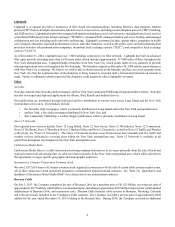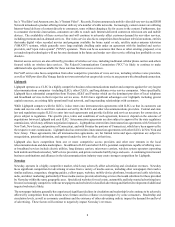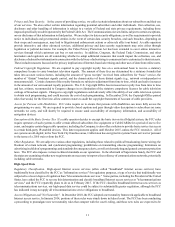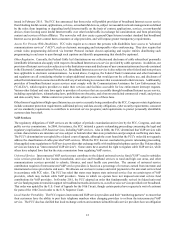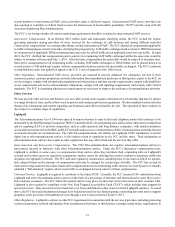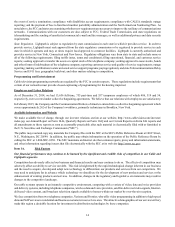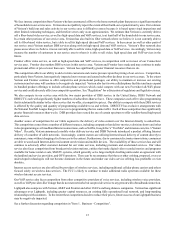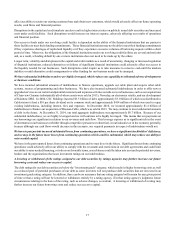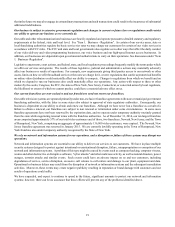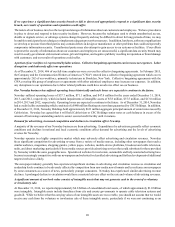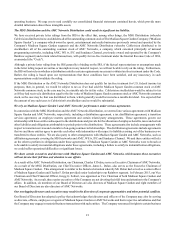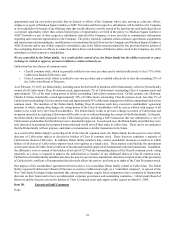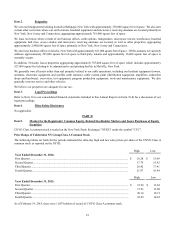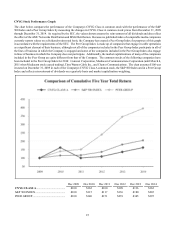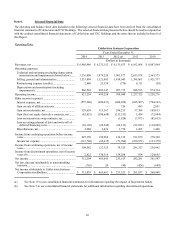Cablevision 2014 Annual Report Download - page 22
Download and view the complete annual report
Please find page 22 of the 2014 Cablevision annual report below. You can navigate through the pages in the report by either clicking on the pages listed below, or by using the keyword search tool below to find specific information within the annual report.16
We face significant risks as a result of rapid changes in technology and consumer expectations and behavior.
The telecommunications services industry has undergone significant technological development over time and these changes
continue to affect our business. Such changes have had, and will continue to have, a profound impact on consumer expectations
and behavior. Our video business faces technological change risks as a result of the continuing development of new and changing
methods for delivery of programming content such as Internet based delivery of movies, shows and other content which can be
viewed on televisions, wireless devices and other developing mobile devices. A proliferation of delivery systems for video content
can adversely affect our ability to attract and retain subscribers and the demand for our services and it can also decrease advertising
demand on our delivery systems. Our high-speed data business faces technological challenges from rapidly evolving wireless
Internet solutions. Our voice service offerings face technological developments in the proliferation of voice delivery systems
including those based on Internet and wireless delivery. If we do not develop or acquire and successfully implement new
technologies, we will limit our ability to compete effectively for subscribers, content and advertising. In addition, we may be
required to make material capital and other investments to anticipate and to keep up with technological change. These challenges
could adversely affect our business.
Programming costs of our Cable segment are increasing and we may not have the ability to pass these increases on to our
subscribers. Disputes with programmers can adversely affect our relationship with subscribers and lead to subscriber losses.
Programming costs paid by our Cable segment are one of our largest categories of expenses. These costs have increased rapidly
and are expected to continue to increase, particularly with respect to costs for sports programming and broadcast networks. We
may not be able to pass programming cost increases on to our subscribers due to the increasingly competitive environment. If we
are unable to pass these increased programming costs on to our subscribers, our operating results would be adversely affected.
We attempt to control our programming costs and, therefore, the cost of our video services to our customers by negotiating favorable
terms for the renewal of our affiliation agreements with programmers. On certain occasions in the past, such negotiations have
led to disputes with programmers that have resulted in temporary periods where we were not carrying a particular broadcast network
or programming service or services. Such disputes may inconvenience some of our subscribers and can lead to customer
dissatisfaction and, in certain cases, the loss of customers.
The financial markets are subject to volatility and disruptions, which have in the past, and may in the future, adversely affect
our business, including by affecting the cost of new capital, our ability to refinance our scheduled debt maturities and our
ability to meet our other obligations as they come due.
The capital and credit markets experience volatility and disruption. At times, the markets have exerted extreme downward pressure
on stock prices and upward pressure on the cost of new debt capital and have severely restricted credit availability for most issuers.
Market disruptions in the past were accompanied by a broader economic downturn, which led to lower demand for our products,
such as video services, as well as lower levels of television and newspaper advertising, and increased incidence of customers'
inability to pay for the services we provide. A recurrence of those conditions may further adversely impact our results of operations,
cash flows and financial position.
We rely on the capital markets, particularly for offerings of debt securities, as well as the credit markets, to meet our financial
commitments and liquidity needs. Disruptions and/or volatility in the capital and credit markets could adversely affect our ability
to refinance on satisfactory terms, or at all, our scheduled debt maturities and could adversely affect our ability to draw on our
revolving credit facility.
Economic downturns may impact our ability to comply with the covenants and restrictions in our indentures, credit facilities and
agreements governing our other indebtedness and may impact our ability to pay our indebtedness as it comes due. If we do not
repay our debt obligations when they become due and do not otherwise comply with the covenants and restrictions in our indentures,
credit facilities and agreements governing our other indebtedness, we would be in default under those agreements, and the debt
incurred under those agreements could then be declared immediately due and payable. In addition, any default under our indentures,
credit facilities or agreements governing our other indebtedness could lead to an acceleration of debt under other debt instruments
that contain cross acceleration or cross-default provisions. If the indebtedness under our indentures, credit facilities and our other
debt instruments were accelerated, we would not have sufficient assets to repay amounts due thereunder. To avoid a default, we
could be required to defer capital expenditures, sell assets, seek strategic investments from third parties or reduce or eliminate
dividend payments and stock repurchases or other discretionary uses of cash. However, if such measures were to become necessary,
there can be no assurance that we would be able to sell sufficient assets or raise strategic investment capital sufficient to meet our
scheduled debt maturities as they come due. In addition, any significant reduction in necessary capital expenditures could adversely


